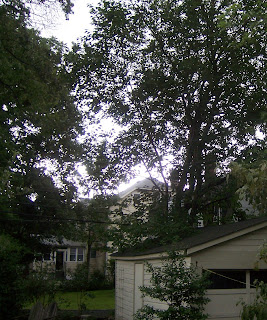Our back yard has a dead zone, a corner that gets too much water and too little light.* Early this spring, it became clear that two plants back there, a skip laurel and a holly (I think blue princess but I forget...) -- each of which had thriving twins not far away -- were at death's door, the holly two thirds brown, the laurel spotted and nearly bare. Below, the two sick plants, followed by the healthy holly twin (with healthy laurel in background).
We consulted with a neighbor of gardening genius. He had us move each of the ailing plants 2-3 feet to improve their access to light, build up the soil (earlier, he'd steered us toward putting in a drainage channel and the thriving uphill holly to soak up some of the excess water), and fertilize. We also treated the laurel with an anti-fungal spray.
Both plants stabilized. Healthy growth stopped turning brown or spotted. Each put out a few green shoots.
And that was it. Both remain in a kind of suspended animation, two thirds bare with no dead wood or leaves.
It occurs to me that this southeast corner of our garden has neatly tracked the nation's economy -- a near-death experience, followed by stabilization and short growth spurt that quickly stalled.
What economic lessons can be extracted from this extended analogy? Absolutely none. But it's striking, nonetheless.
INSTA-UPDATE: Come now, you can do better than that. Plainly, the problems in that corner are structural: the whole housing lot runs downhill to it, making it too wet; and a tree to the right, behind the garage that defines its border, overshadows it (n.b. the large tree to the left is far back, not at issue).
What that corner requires is radical reform: cutting down the tree (break up the megabanks!), running a drainage pipe alongside the garage (resolution authority!), and dumping a couple of truckfulls (trucks full?) of dirt on the back half of the lawn to level it, then reseeding it (education reform!).
Will we undertake this package of bold structural reforms? Nah...
* The ten year body count in that corner include an apple tree, a butterfly bush, and a birch (planted because of its high tolerance for water).



No comments:
Post a Comment